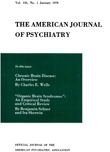SENESCENCE, SENILITY, AND ALZHEIMER'S DISEASE
Abstract
1. Two-hundred-seventy cases of patients, aged 60 to 97 years, were reviewed and observations recorded.
2. The largest number suffered from a chronic brain syndrome with arteriosclerotic brain disease. Typical arteriosclerotic vascular changes in small vessels were found in 57 patients and mixed arteriosclerotic and senile changes in 93 patients in this group.
3. Examination of patients with senile brain disease revealed the presence of brain atrophy not proportionate to the age of the patient or the duration of his illness; small to moderate numbers of senile plaques in all; mild to moderate arteriosclerotic changes of large vessels at the base of the brain in many; and a few Alzheimer's fibrillary changes in 4 patients.
4. Eighteen patients previously diagnosed as having arteriosclerotic or senile brain disease who showed typical clinical and neuropathological findings of Alzheimer's disease were so classified regardless of their advanced age and the late onset of the illness.
5. Of the 51 patients with psychoses of different etiology who grew old and died at the state hospital, 48 showed arteriosclerosis and senile changes of mild to moderate degree. Three with "functional" psychosis had apparently normal brains.
6. The degree of brain atrophy was not always indicative of the patient's mental deterioration. Some patients with greatly atrophied brains showed better compensatory mechanisms than others with less pronounced atrophy.
7. From these considerations it follows that 3 approaches are open now for the prevention and treatment of psychoses of old age: ultimate control of general arteriosclerosis, of which cerebral arteriosclerosis is a part; biochemical studies; and last, but not least, keeping old people motivated to use their remaining mental resources.
Access content
To read the fulltext, please use one of the options below to sign in or purchase access.- Personal login
- Institutional Login
- Sign in via OpenAthens
- Register for access
-
Please login/register if you wish to pair your device and check access availability.
Not a subscriber?
PsychiatryOnline subscription options offer access to the DSM-5 library, books, journals, CME, and patient resources. This all-in-one virtual library provides psychiatrists and mental health professionals with key resources for diagnosis, treatment, research, and professional development.
Need more help? PsychiatryOnline Customer Service may be reached by emailing [email protected] or by calling 800-368-5777 (in the U.S.) or 703-907-7322 (outside the U.S.).



